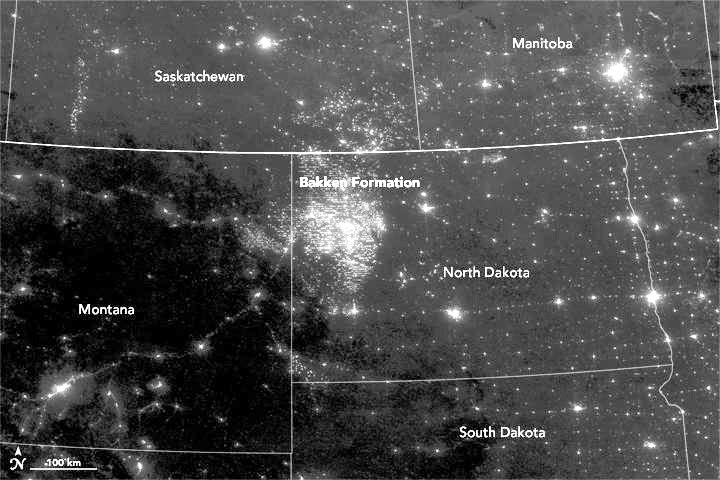WSU researchers develop alternative to wasteful methane flaring

Satellite imagery shows electric lights and methane flaring in North Dakota's Bakken Formation. Washington State University engineers have built a reactor that can convert methane into more benign, easily used forms. Credit: NASA's Earth Observatory
Jean-Sabin McEwen knocks out a web search for “North Dakota,” “night sky” and “flaring,” and quickly finds a picture from space showing a glowing cluster bigger than Minneapolis. It's from oil and gas fields burning off methane, producing as much greenhouse gas in a year as 1 million cars.
“It's a big problem because not only do you waste energy, but you produce CO2,” says Su Ha, a Washington State University associate professor of chemical engineering and director of the O.H. Reaugh Laboratory for Oil and Gas Research. “So the question is: Is there something you can do better than that?”
Ha and McEwen, a WSU assistant professor of chemical engineering, say they have a solution: a small reactor that inexpensively breaks water and methane into carbon monoxide and hydrogen, which can be used for energy and industrial products. They report their discovery in the journal ACS Catalysis.
Methane, the primary component of natural gas, is a frequent byproduct of oil drilling. It is also a greenhouse gas 34 times more potent than carbon dioxide over the course of a century.
Piping it from remote areas is expensive, so energy companies burn off about one-third of the gas they produce in bright flares that can be seen from space. U.S. and Russian researchers in 2015 said flares around the planet accounted for 3.5 percent of the world's natural gas consumption.
McEwen and Ha's solution involves breaking down the methane in the field.
Ordinarily, methane is such a tightly bonded molecule that breaking it apart requires a lot of water and temperatures of about more than 1,800 F. But McEwen and Ha found that they could use much lower operating temperatures and an inexpensive nickel catalyst in the presence of an electrical field to orient methane and water in a way that makes them easier to break apart.
“It's like a combination lock,” said Ha. “When you apply the right combination, when you apply the electric field with the right strength and right direction, it's like you are applying a combination to a lock and click, it opens.”
At the end of the process, the researchers end up with carbon monoxide and hydrogen, the ingredients of syngas, or synthetic gas. The product can be used to make gasoline, or the reactor could be attached to fuel cells that convert and store the energy as electricity.
“The idea is to have something that is better suited to these remote areas than a large-scale reactor,” said McEwen.
###
Graduate students Fanglin Che and Jake Gray contributed to the research, which was funded in part by the USDA/NIFA Hatch Project, the O.H. Reaugh Endowment Fund and the American Chemical Society Petroleum Research Fund.
The work is in keeping with Washington State University's Grand Challenges, a suite of initiatives aimed at addressing large societal problems. It is particularly relevant to the energy and water themes of the Sustainable Resources challenge.
Media Contact
All latest news from the category: Power and Electrical Engineering
This topic covers issues related to energy generation, conversion, transportation and consumption and how the industry is addressing the challenge of energy efficiency in general.
innovations-report provides in-depth and informative reports and articles on subjects ranging from wind energy, fuel cell technology, solar energy, geothermal energy, petroleum, gas, nuclear engineering, alternative energy and energy efficiency to fusion, hydrogen and superconductor technologies.
Newest articles

Superradiant atoms could push the boundaries of how precisely time can be measured
Superradiant atoms can help us measure time more precisely than ever. In a new study, researchers from the University of Copenhagen present a new method for measuring the time interval,…

Ion thermoelectric conversion devices for near room temperature
The electrode sheet of the thermoelectric device consists of ionic hydrogel, which is sandwiched between the electrodes to form, and the Prussian blue on the electrode undergoes a redox reaction…

Zap Energy achieves 37-million-degree temperatures in a compact device
New publication reports record electron temperatures for a small-scale, sheared-flow-stabilized Z-pinch fusion device. In the nine decades since humans first produced fusion reactions, only a few fusion technologies have demonstrated…





















